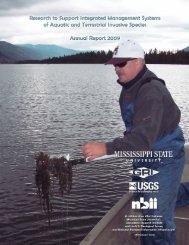Bushkiller - Geosystems Research Institute - Mississippi State ...
Bushkiller - Geosystems Research Institute - Mississippi State ...
Bushkiller - Geosystems Research Institute - Mississippi State ...
You also want an ePaper? Increase the reach of your titles
YUMPU automatically turns print PDFs into web optimized ePapers that Google loves.
Distribution<br />
US<br />
<strong>Bushkiller</strong> is native to Southeast Asia and Australia and reported in Japan, southern China, Indo-China, the Philippines,<br />
Taiwan, New Caledonia, New Guinea, and Queensland. <strong>Bushkiller</strong> was cultivated in the United <strong>State</strong>s sometime before<br />
1964, but has escaped in the southern U.S. with known occurrences in California, Louisiana, <strong>Mississippi</strong>, North Carolina,<br />
and Texas. It has survived winters in Zone 7b, although foliage was severely damaged.<br />
MidSouth<br />
In the MidSouth, bushkiller occurs in Louisiana and <strong>Mississippi</strong>. In <strong>Mississippi</strong>, its occurrences in new counties continue<br />
to be reported. Currently, it has been reported in Jackson, Lincoln, Pike, and Webster Counties in <strong>Mississippi</strong>. In Louisiana,<br />
it occurs at scattered localities but forms dense stands in areas near the <strong>Mississippi</strong> River from Baton Rouge to<br />
Control Methods<br />
Biological<br />
No biological controls are currently being utilized for bushkiller control.<br />
Chemical<br />
More research is needed on bushkiller control, since there are no label recommendations.<br />
Mechanical<br />
Mechanical controls can be used for bushkiller control, but tend to be expensive and labor intensive. Roots left in the soil<br />
can regenerated shoots, thus hand removal must be thorough. Pulling shoots without removing roots can take a long<br />
period of time and probably not a feasible means of eradication.<br />
References<br />
USDA, NRCS. 2007. The PLANTS Database (http://plants.usda.gov, 6 August 2007). National Plant Data Center, Baton<br />
Rouge, LA 70874-4490 USA.<br />
More Information<br />
There are 63 species of Cayratia A.L. Jussieu distributed mostly in tropical and subtropical Africa, Asia, Australia, and<br />
the Pacific Islands. The Genus Cayratia belongs to the Grape Family (Vitaceae) and apparently only one species, bushkiller<br />
(C. japonica), occurs in the continental United <strong>State</strong>s. Cayratia trifolia (L.) Domin occurs in Hawaii.<br />
John D. Madsen, Ph.D.<br />
<strong>Mississippi</strong> <strong>State</strong> University, <strong>Geosystems</strong> <strong>Research</strong> <strong>Institute</strong><br />
Box 9652, <strong>Mississippi</strong> <strong>State</strong>, MS 39762-9652<br />
Ph. (662)325-2428, jmadsen@gri.msstate.edu<br />
www.gri.msstate.edu




